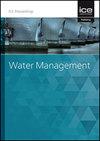Prediction of scour depth around bridge abutments with different shapes using machine learning models
IF 0.9
4区 工程技术
Q3 ENGINEERING, CIVIL
Proceedings of the Institution of Civil Engineers-Water Management
Pub Date : 2023-10-05
DOI:10.1680/jwama.22.00087
引用次数: 0
Abstract
Accurate assessment of scour depth around bridge abutments is crucial to reasonable design of abutment structures. In this study, machine learning (ML) models are implemented, including M5′ model tree (M5′MT), multivariate adaptive regression spline (MARS), locally weighted polynomial regression (LWPR) and multigene genetic programming (MGGP) to predict scour depth around vertical-wall, 45° wing-wall and semicircular bridge abutments. Published experimental data are adopted, with four input parameters considered for the prediction of relative scour depth. The optimal input combination for each model is first determined using correlation and sensitivity analyses; results reveal that MGGP exhibits the best agreement with experimental data for vertical-wall and semicircular abutments, whereas LWPR outperforms the other models for the 45° wing-wall abutment. In addition, compared with the empirical equations and ML models employed in the literature, the accuracy of scour depth prediction is significantly improved with the ML models used in this study. Considering the comprehensive performance for all types of abutments in terms of accuracy, reliability and interpretability, MGGP is recommended as the representative of the implemented ML models with its mean absolute percentage error of 2.40% for a vertical-wall abutment, 3.95% for a 45° wing-wall abutment and 3.85% for a semicircular abutment.利用机器学习模型预测不同形状桥台周围冲刷深度
准确评估桥台周围冲刷深度对桥台结构的合理设计至关重要。本研究采用机器学习(ML)模型,包括M5 '模型树(M5 ' mt)、多元自适应回归样条(MARS)、局部加权多项式回归(LWPR)和多基因遗传规划(MGGP)来预测垂直壁、45°翼壁和半圆形桥台周围的冲刷深度。采用已发表的实验数据,考虑4个输入参数预测相对冲刷深度。首先使用相关性和敏感性分析确定每个模型的最佳输入组合;结果表明,MGGP模型在垂直壁面和半圆形桥台上与实验数据吻合最好,而LWPR模型在45°翼壁面桥台上的表现优于其他模型。此外,与文献中使用的经验方程和ML模型相比,本研究使用的ML模型显著提高了冲刷深度预测的准确性。考虑到各类型基台在精度、可靠性和可解释性方面的综合性能,推荐MGGP作为已实现的ML模型的代表,其平均绝对百分比误差为:垂直墙基台2.40%,45°翼墙基台3.95%,半圆形基台3.85%。
本文章由计算机程序翻译,如有差异,请以英文原文为准。
求助全文
约1分钟内获得全文
求助全文
来源期刊
CiteScore
2.10
自引率
0.00%
发文量
28
审稿时长
6-12 weeks
期刊介绍:
Water Management publishes papers on all aspects of water treatment, water supply, river, wetland and catchment management, inland waterways and urban regeneration.
Topics covered: applied fluid dynamics and water (including supply, treatment and sewerage) and river engineering; together with the increasingly important fields of wetland and catchment management, groundwater and contaminated land, waterfront development and urban regeneration. The scope also covers hydroinformatics tools, risk and uncertainty methods, as well as environmental, social and economic issues relating to sustainable development.

 求助内容:
求助内容: 应助结果提醒方式:
应助结果提醒方式:


